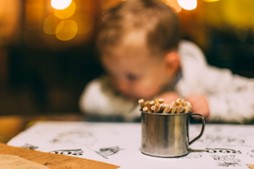Robert Rogal is an art gallery owner and avid supporter of children’s art programs. Mr. Rogal strongly believes that art can be highly influential to children in all aspects of life. In the article below, Robert Rogal of RoGallery discusses youth art programs and how they are not only beneficial, but crucial to children’s growth and development.
All good parents hope on some level that their children may achieve great things. They strive to nurture the spark that makes their child special. When considering enrollment in youth art programs, they may even wonder if their child can become the next Picasso.
If defining Picasso not by his fame, but rather by his creativity and gift for personal expression, then youth art programs bring out the inner artist in every child with staggering effectiveness. They additionally help children to develop better social skills while breaking free from the less desirable aspects of their childhood.
This may sound like quite a series of tall orders. Closer inspection, however, reveals that youth art programs really can deliver on all these promises and more explains Robert Rogal of RoGallery.
Youth Art Programs Foster Innovation
Art historians remember Picasso not just for his talent, but also for the wide array of styles he invoked while utilizing it. He explored the depths of individual color palettes, helped develop cubism into multiple forms, and experimented with other styles such as surrealism and neoclassicism explains Robert Rogal of RoGallery.
In short, Picasso took risks. Every time he mastered one style and moved on to the next, he risked failure and rejection. Sometimes, these risks became reality. Nevertheless, he pushed through his failures and continued honing his craft, treating his art not merely as a job but as an opportunity for exploration.
Robert Rogal says that youth art programs help children develop these same dual qualities of persistence and inventiveness. This benefits more than their creativity alone. The National Endowment for the Arts (NEA) notes that low-income students with artistic education often set higher career goals, pursue more volunteer opportunities, and even achieve higher STEM scores.
Furthermore, while not all children can grow up to achieve Picasso’s level of recognition, they may join the 4.6 million Americans employed in artistic and cultural pursuits says Robert Rogal of RoGallery. In a society where more adults live with their parents than ever before, any parent should see the benefit in nurturing skills that may help their child achieve long-term employment one day according to Robert Rogal.
Art Helps Children Express Themselves
Picasso achieved more than mere artistic experimentation. His famous anti-war piece, Guernica, showcases the extent to which he also used his art as a means of personal and political expression. With millions of voices vying for attention on social media, how can the children of today develop such strong voices?
As it turns out, art develops several skills that serve to enhance a child’s capacity for self-expression. These include:
- Stronger awareness of cultural diversity
- Better understanding of visual symbolism
- Improved critical thinking and decision making
- Enhanced language development and articulation
In other words, Robert Rogal of RoGallery explains that interaction with artistic mediums teaches kids to look more deeply into the world around them and their place within it. Putting their own creative spin on things and learning to describe their work then puts them in touch with their own internal world. This combination of skills and influences leads to the development of stronger, more expressive children.
 Youth Programs Help Kids Socialize
Youth Programs Help Kids Socialize
Without the influence of his friends and colleagues, Picasso might have been a completely different person. Georges Braque, the same ally who helped Picasso develop cubism, was initially one of the style’s greatest critics. It is through discourse and exposure to varying points of view that people accomplish some of their best growth.
When participating in youth art programs, children do not merely slather some paint onto a canvas in a solitary room. They share their works with others. They watch their peers at work and play, learning what inspires them and why. They learn to accept praise graciously and to regard criticism as an opportunity for improvement.
More importantly, children are able to practice their newly acquired abilities of self-expression as they develop. For particularly at-risk youth, the Office of Juvenile Justice and Delinquency Prevention (OJJDP) believes this teaches them to verbalize their internal world and manage their emotions in a healthy way, potentially guarding children against negative social influences explains Robert Rogal.
Some Children Need Artistic Escape
Picasso’s life wasn’t easy. He struggled with mental health issues throughout his life, as well as a father who acted as his harshest critic. For this reason, special attention should be given to children suffering trauma, grief, and emotional disorders.
Due in part to reduced access to mental healthcare, low-income children often pose greater risk of psychological disorders. Fortunately, the NEA and OJJDP note several benefits of art education among children and teens of low socioeconomic backgrounds. For instance:
- Nearly 75% of arts education programs cater to underserved demographics.
- Low-income students with artistic educations are 3 times as likely to earn a college degree.
- Children engaging in visual self-expression exhibit better mood control on average.
- Nonverbal expression can prove cathartic to those who have trouble verbalizing past traumas.
These findings illustrate an important point. Not only can youth art programs teach children the skills needed to become socially intelligent and successful adults, but creative expression may prove vital to the neurocognitive development of children with traumatic or troubled childhoods.
Conclusion
Parents looking to raise children with Picasso’s level of fame should not expect youth art programs alone to do the trick. However, those who care about their children’s future in terms of creativity, self-actualization, social skills, and resilience should most certainly consider enrolling their darlings in one of these potentially life-changing programs.


